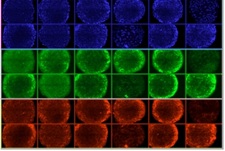MIT researchers develop a better way to grow stem cells
By Anne Trafton, MIT News Office | 23 Aug 2010
CAMBRIDGE, Mass. - Human pluripotent stem cells, which can become any other kind of body cell, hold great potential to treat a wide range of ailments, including Parkinson's disease, multiple sclerosis and spinal cord injuries.
 |
| This image shows rows of human embryonic stem cells that MIT researchers grew on a new synthetic surface. The cells at top (blue) are stained to reveal their nuclei, while the cells in the middle and bottom are stained for proteins that are known to be present when cells are pluripotent. Image courtesy of Y. Mei, K. Saha, R. Langer, R. Jaenisch, and D. G. Anderson |
However, scientists who work with such cells have had trouble growing large enough quantities to perform experiments - in particular, to be used in human studies. Furthermore, most materials now used to grow human stem cells include cells or proteins that come from mice embryos, which help stimulate stem-cell growth but would likely cause an immune reaction if injected into a human patient.
To overcome those issues, MIT chemical engineers, materials scientists and biologists have devised a synthetic surface that includes no foreign animal material and allows stem cells to stay alive and continue reproducing themselves for at least three months. It's also the first synthetic material that allows single cells to form colonies of identical cells, which is necessary to identify cells with desired traits and has been difficult to achieve with existing materials.
The research team, led by Professors Robert Langer, Rudolf Jaenisch and Daniel G. Anderson, describes the new material in the Aug. 22 issue of Nature Materials. First authors of the paper are postdoctoral associates Ying Mei and Krishanu Saha.
Human stem cells can come from two sources - embryonic cells or body cells that have been reprogrammed to an immature state. That state, known as pluripotency, allows the cells to develop into any kind of specialized body cells.
It also allows the possibility of treating nearly any kind of disease that involves injuries to cells. Scientists could grow new neurons for patients with spinal cord injuries, for example, or new insulin-producing cells for people with type 1 diabetes.






























